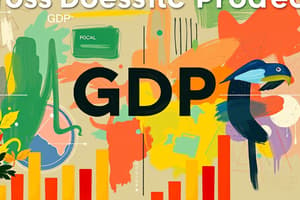Podcast
Questions and Answers
What are the four components of GDP?
What are the four components of GDP?
- Net exports (correct)
- Government purchases (correct)
- Consumption (correct)
- Investment (correct)
What is consumption?
What is consumption?
Spending by households on goods and services.
What is investment?
What is investment?
Investment is the spending on capital equipment, inventories, and structures, including housing purchases by households.
What are Government purchases?
What are Government purchases?
What are Net exports?
What are Net exports?
What does real GDP attempt to do?
What does real GDP attempt to do?
What does real GDP answer?
What does real GDP answer?
What is NOMINAL GDP?
What is NOMINAL GDP?
What is REAL GDP?
What is REAL GDP?
How is real GDP calculated?
How is real GDP calculated?
What does real GDP insure?
What does real GDP insure?
What is the GDP deflator?
What is the GDP deflator?
How is the GDP deflator calculated?
How is the GDP deflator calculated?
What does the GDP deflator do?
What does the GDP deflator do?
Flashcards are hidden until you start studying
Study Notes
Components of GDP
- Four components of GDP: Consumption (C), Investment (I), Government purchases (G), and Net exports (NX).
- GDP formula: Y (GDP) = C + I + G + NX.
Consumption
- Refers to household spending on goods and services.
- A major driving force behind economic activity and growth.
Investment
- Involves spending on capital equipment, inventories, and structures.
- Includes household purchases of housing.
- Critical for long-term economic expansion and productivity.
Government Purchases
- Expenditures by local or national governments on goods and services.
- Excludes transfer payments like social security.
- Influential in stimulating economic activity through public projects and services.
Net Exports
- Represents purchases of domestically produced goods and services by foreign entities.
- Calculated as exports minus imports.
- Reflects the international trade balance affecting domestic output.
Real GDP
- Measures output of goods and services in the economy without adjusting for price changes.
- Utilizes fixed prices from a base year for calculations.
- Allows for analysis of economic growth that is not distorted by inflation.
Nominal GDP
- Measures production of goods and services at current market prices.
- Does not account for inflation or changes in price levels over time.
Calculation of Real GDP
- Based on a chosen base year to determine fixed prices.
- Subsequent outputs are multiplied by the base year prices to calculate real GDP.
- Example: If the base year is 2009 with a sausage price of £2.50, that price is used for future output calculations.
Importance of Real GDP
- Provides insights into actual changes in domestic production and output.
- Reflects consumer satisfaction more accurately than nominal GDP, which includes price level changes.
GDP Deflator
- A key measure of the price level, calculated as the ratio of nominal GDP to real GDP, multiplied by 100.
- Indicates how price levels have changed compared to a base year.
Calculation of the GDP Deflator
- Formula: GDP Deflator = (Nominal GDP / Real GDP) x 100.
- A higher deflator suggests significant price level increases.
Interpretation of GDP Deflator Changes
- Indicates the overall price level in the economy relative to a base year.
- Example: A rise from 100 to 171 in the GDP deflator signifies a 71% increase in price levels over the year.
Studying That Suits You
Use AI to generate personalized quizzes and flashcards to suit your learning preferences.




